Naselje se je s prvotnih 50 hiš in 300 prebivalcev razširilo na 300 hiš s 1030 prebivalcev. Osrednja cesta je bila Koroška cesta, ki se je razširila v mestni trg – Glavni trg in je bila dolgo časa glavna prometna žila iz Maribora proti Koroški in Gradcu. Potekala pa je skozi tako imenovana Koroška vrata na zahodni stranici mestnega obzidja.
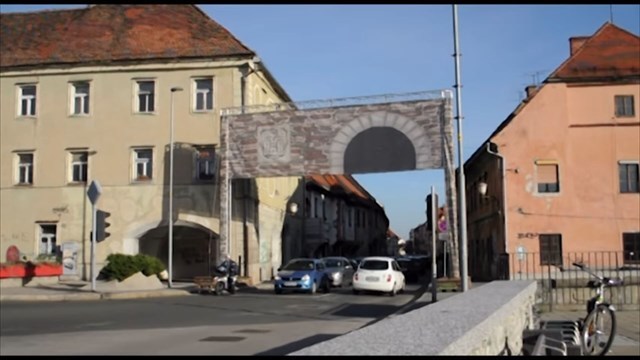
Koroška vrata - kulise obzidja (2013)
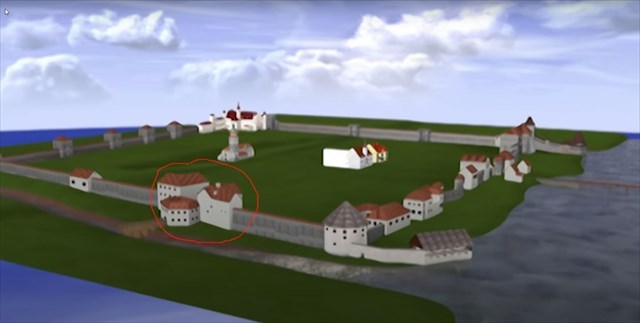
Digitalna 3D rekonstrukcija Koroških vrat
Maribor je v obdobju 1255–1275 dobil obzidje kot znak pravnega statusa mestne naselbine in kot obrambno sredstvo. Obzidje je prebivalcem in prišlekom nudilo varnost in zavetje v mestu. Dva kilometra dolgo rombasto obzidje z okoli 500 metrov dolgimi stranicami je zamejilo okoli 25 hektarjev zemljišča med Dravo in današnjo Strossmayerjevo ulico, Gregorčičevo ulico in Ulico slovenske osamosvojitve z Ulico škofa Maksimilijana Držečnika (nekdanja Svetozarevska ulica).

Prikaz lokacije Koroških vrat na stari sliki
Vstop v mesto so omogočala tri glavna mestna vrata, to so bila Koroška, Dravska in Graška vrata ter tri manjša vrata in sicer Grajska, Pristaniška in Židovska vrata. Prve začetke izgradnje tega utrjenega prehoda imenovanega tudi Gospejna ali Gornja vrata lahko zasledimo v letu 1300. Vrata v drugi polovici 15. st. dodatno utrdijo s polkrožnim barbakanom (mala utrdba postavljena pred trdnjavo).
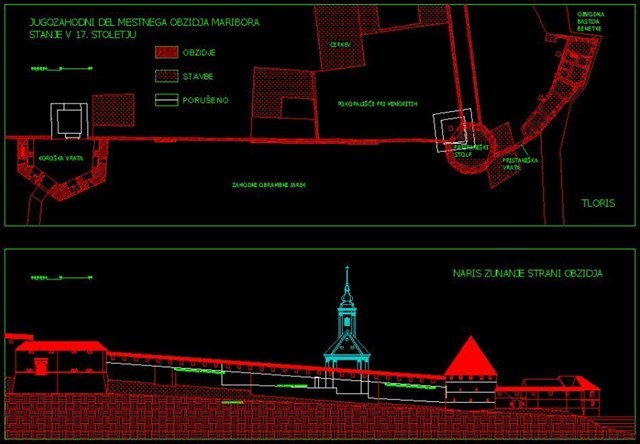
Digitalna rekonstrukcija obzidja (Koroška vrata so skrajno levo)
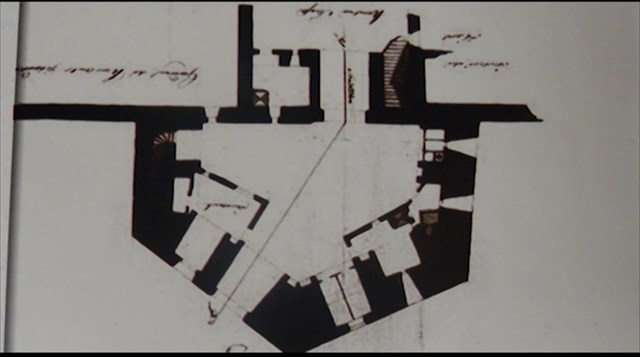
Polkrožni barbakan
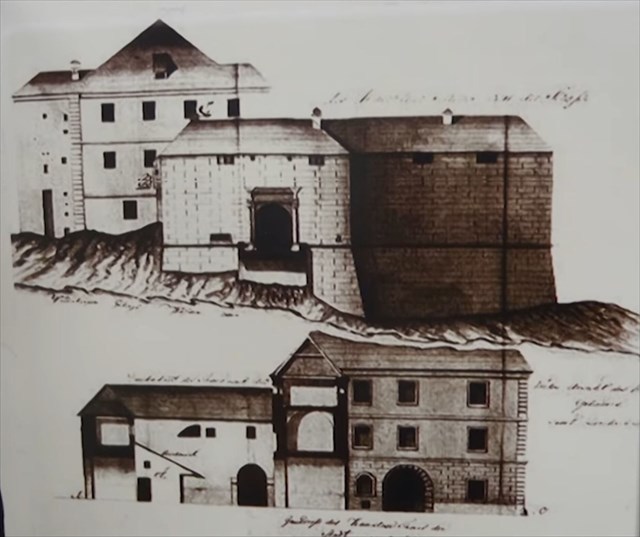
Utrdba
V 16. stoletju barbakan zamenjajo s peterokrako bastijo, ki je imela notranje dvorišče, nadstropne strelne line, skoznje pa je bila speljana vjugasta cesta. Ker je tik ob obzidju potekal obrambni jarek, so bila vrata oz. vhod v mesto povezana z mostom.

Most preko obrambnega jarka
Leta 1829 so utrjen vhod porušili. Na temeljih ostanka Koroških mestnih vrat so potem zgradili kapelo, ki pa so jo podrli junija 1953 med urejanjem nove mestne tržnice.

Kapela zgrajena po letu 1829

Odkopani ostanki bastije leta 2009 ob rekonstrukciji tržnice
Danes nas na Koroška vrata spominjata le grbovna reliefa vzidana na Koroški cesti pri tržnici.
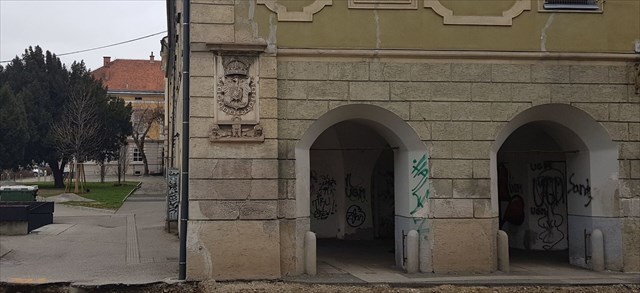
Spominski relief na severni strani

Spominski relief na južni strani
Grbovni relief na steni stavbe Koroška cesta 21 prikazuje grb, ki ga je mesto Maribor takrat imelo. Grb, katerega najstarejši odtis je ohranjen na listini iz leta 1288, je še danes grb mesta Maribora.

Grb mesta Maribor
Ohranjen je tudi eden od ključev mestnih vrat, ki ga hranijo v muzeju, vendar ni znano, katera vrata je odklepal.

Ključ od mestnih vrat
Viri:
http://www2.arnes.si/~ssmbkmet2s/obvestila/MARIBORSKI%20SREDNJEVESKI%20OBRAMBNI%20SISTEM.pdf
https://www.kamra.si/digitalne-zbirke/mariborsko-obzidje/
https://www.youtube.com/watch?v=55I8Y9OqBao
https://www.facebook.com/pomum123/videos/mestno-obzidje/222995072451639/
https://www.google.com/maps
EN
Ancient entrance Carinthian Gate
The village of Maribor under the castle on hill Piramida originated as a colonization village. It developed rapidly and soon grew into a city along the Drava. In 1209 the village received market rights and in 1254 Maribor became a city. The rapid rise began after 1282 when the Habsburgs ruled the Maribor.
The village has expanded from its original 50 houses and 300 inhabitants to 300 houses with 1030 inhabitants. The main road was Koroška cesta, which expanded into the town square (Glavni trg) and was for a long time the main traffic artery from Maribor to Koroška and Graz. It passed through the so-called Carinthian Gate on the west side of the city walls.

Carinthian Gate - reconstruction (2013)

Digital 3D reconstruction of the Carinthian Gate
In the period 1255–1275 in Maribor was built a wall as a sign of the legal status of an urban village and for defense. The walls provided security and shelter for the residents and newcomers in the city. A two-kilometer-long diamond-shaped wall with about 500 meters long sides bounded about 25 hectares of land between the Drava and today's Strossmayerjeva ulica, Gregorčičeva ulica and Ulica slovenske osamosvojitve with Ulica škofa Maksimilijana Držečnika (former Svetozarevska ulica).

The location of the Carinthian Gate in the old Maribor picture
The entrance to the city was made possible by three main city gates, the Carinthian, Drava and Graz gates, and three smaller gates, named the Castle Gate, the Port Gate and the Jewish Gate. The first beginnings of the construction of this fortified passage, also called Gospejna or Gornja vrata, can be traced back to 1300. The gate in the second half of the 15th century additionally fortified with a semicircular barbican (a small fort placed in front of the fortress).

Digital reconstruction of the walls (Carinthian Gate is on the far left)

Semicircular barbican

Fortress
In the 16th century, the barbican was replaced by a five-legged bastion, which had an inner courtyard, two-storey firing lines, and a winding road leading through it. As a defensive trench ran right next to the wall, the gate or entrance to the city connected by a bridge.

Bridge over the trench
In 1829 the fortified entrance was demolished. A chapel was built on the foundations of the remains of the Carinthian City Gate, but it was demolished in June 1953 during the renovation of the new city market.

Chapel built after 1829

Excavated remains of the bastion in 2009 during the reconstruction of the market
Today only the coat of arms relief on Koroška cesta reminds us of the Carinthian Gate.

Memorial relief on the north side

Memorial relief on the south side
The coat of arms relief on the wall of the Koroška cesta 21 building shows the coat of arms that the city of Maribor had at the time. The coat of arms, the oldest imprint of which is preserved on a document from 1288, is still the coat of arms of the city of Maribor.

Coat of arms of the city of Maribor
One of the keys to the city gate, which is kept in the museum, has also been preserved, but it is not known which door it unlocked.

The key to the city gate